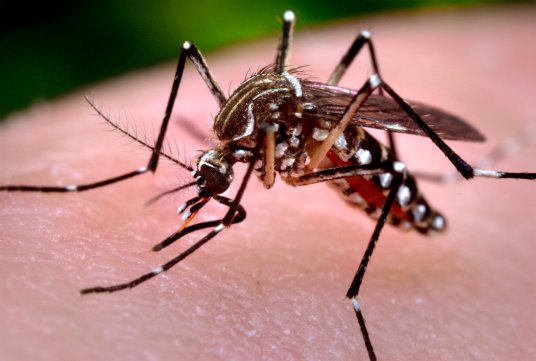What It Is
Chikungunya virus (ChikV) (chik-un-GOON-ya) is transmitted by mosquitoes and causes joint pain and severe arthritis. It’s not normally fatal but is extremely painful and symptoms can last for weeks or even months. In elderly people with compromised health, it can be a contributing factor to fatality.
Symptoms
- Abrupt onset of fever & joint pain
- Joint pain often debilitating
- May last days up to weeks
- Joint pain may persist for several months or years
- In older people, can contribute to death
How It Spreads
- ChikV is spread by two species: Aedes aegypti and Aedes albopictus. Both are day biters.
- They are abundant through about half of the country, primarily in the south and east.
- They are container breeders and bite in or near homes and schools
- Unlike West Nile, humans are the reservoir for the virus – meaning that if a mosquito bites an infected human, it will become infected and can spread ChikV to other humans.
- Travelers returning from tropical climates are the ones bringing the virus back to the U.S. If Aedes albopictus or Aedes aegypti are present in your area and bite an infected returning traveler, local transmission can amplify.
- Even though Ae. albopictus and Ae. aegypti eggs can overwinter, the ability for an infected female to transmit the virus to progeny is very, very unlikely. By and large, these adults don’t survive the winter, CHIKV will not circulate (and will not be transmitted) until re-introduced by human travelers. That said, temperate areas with enough moisture can aid adults to overwinter.
How Is ChikV Detected

- Symptoms appear generally 4 – 8 days once bitten by an infected mosquito.
- 72 – 90% of those infected develop symptoms.
- At this time, there are no tests for ChikV in mosquito pools, only in human blood samples.
Why Are Aedes Mosquitoes Challenging to Control?
- Ae. aegypti and Ae. albopictus are diurnal mosquitoes – active in daytime, resting in sheltered areas at night, especially Ae. aegypti.
- Aedes mosquitoes breed in sheltered areas and containers, like tires, gutters, pots, and wheelbarrows. Larviciding must reach these sheltered areas to be effective.
- Because Aedes rest at night, traditional adulticiding is difficult because mosquitoes are protected from contact with the adulticide.
What Should Mosquito Professionals Do?
- Identify whether you’re in an area likely to have ChikV (i.e., an area with significant populations of Ae. albopictus and Ae. aegypti).
- Maintain surveillance and species counts for Aedes mosquitoes
- Implement a larval source reduction plan. Aerial larviciding with a liquid or granule, as well as ground ULV larviciding, have been used to reach containers of all sizes.
- Educate residents to reduce breeding sites, use repellent and wear long sleeves and pants.
- Enlist volunteers to help get the word out in addition to posting on community websites, district websites and media outreach.
- If a case is identified, quickly learn if it was locally transmitted or an imported case. Make sure the correct information is being conveyed in the media. To date, most ChikV is imported by travelers who were infected in other areas and developed symptoms upon their return home.
- Use vector-appropriate adult control as human cases emerge. Why wait? Because a human has to bring it into the area. Since Aedes have a short flight range, activating adult control around human case tends to be the most efficient approach to adult treatment.
What Are Tools for Suppressing Outbreaks of ChikV?
- There are no medications or vaccinations for ChikV, only pain medication to treat symptoms.
- Rotate larvicides to avoid resistance. Natular’s active ingredient, spinosad, has a unique mode of action and novel class of chemistry.
- Because Ae. albopictus and Ae. aegypti are more active in daytime hours, if mosquito control is done in the evening/early morning hours using an adulticide with an agent to excite resting mosquitoes (i.e., Duet®) would aid in controlling more of the natural population. Traditional adult control products and protocols may not provide effective control at levels necessary to control outbreaks.
Resources
The following resources are available on the Clarke website (Home Page link): www.clarke.com
Product trials & publication links:
- Area-wide management of Aedes albopictus. Part 2: Gauging the efficacy of traditional integrated pest control measures against urban container mosquitoes.
- Prallethrin-Induced Excitation Increases Contact Between Sprayed Ultralow Volume Droplets and Flying Mosquitoes (Diptera: Culicidae) in a Wind Tunnel
- Behavioral Responses of Two Dengue Virus Vectors, Aedes aegypti and Aedes albopictus (Diptera: Culicidae), to DUET and its Components
- Effectiveness of Ultra-Low Volume Nighttime Applications of an Adulticide against Diurnal Aedes albopictus, a Critical Vector of Dengue and Chikungunya Viruses
- Efficacy of Duet™ Dual-Action Adulticide Against Caged Aedes albopictus With The Use Of An Ultra-Low Volume Cold Aerosol Sprayer
- Florida Dengue Workshop Introductory Talks 2014
- Florida ChikV & Dengue Workshop Working Group Summaries June 2014
CDC Link
www.cdc.gov/chikungunya
Labels available on the Clarke website (Labels/MSDS):
- Duet
- Natular G30
- Natular EC
- Natular T30
